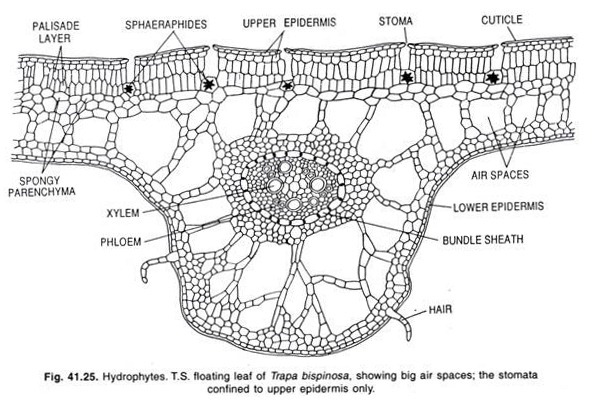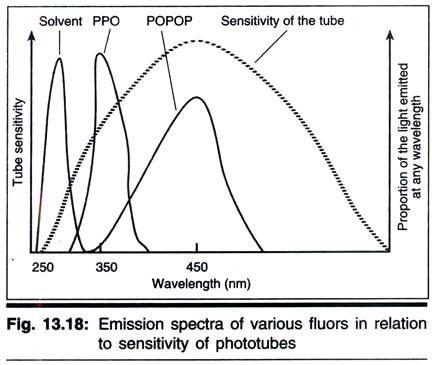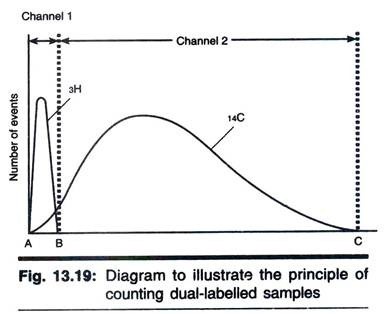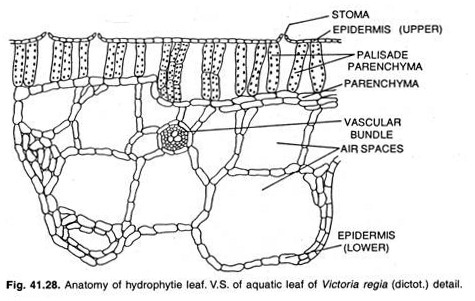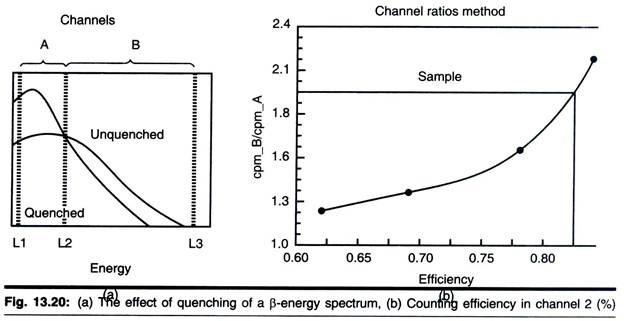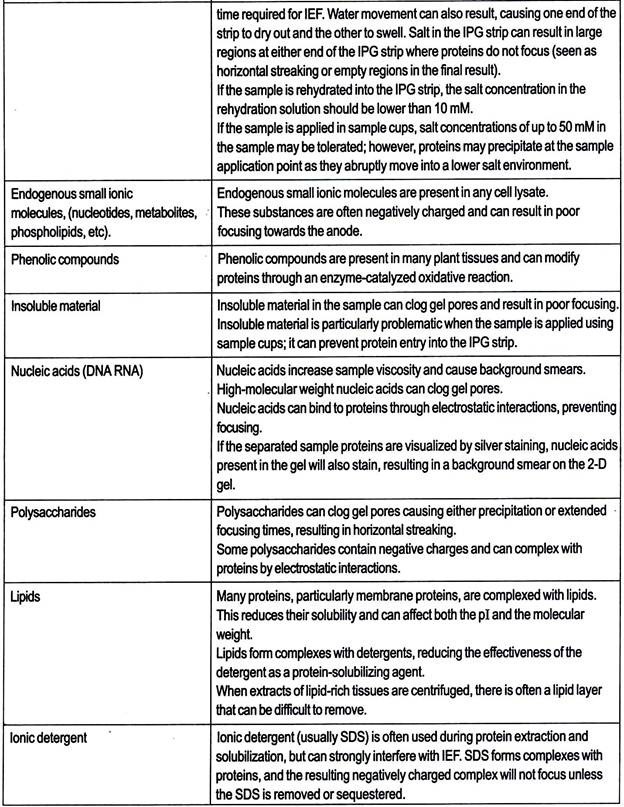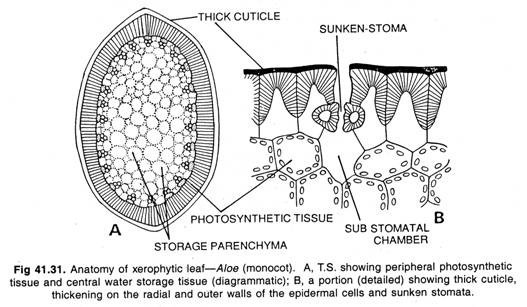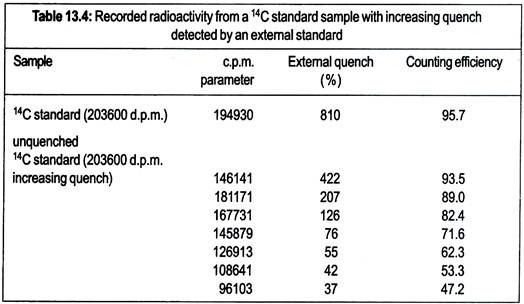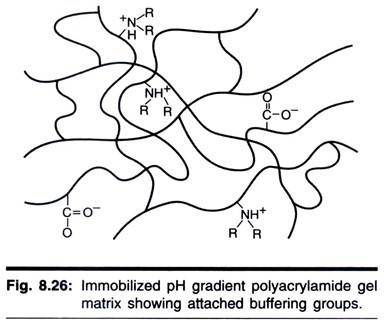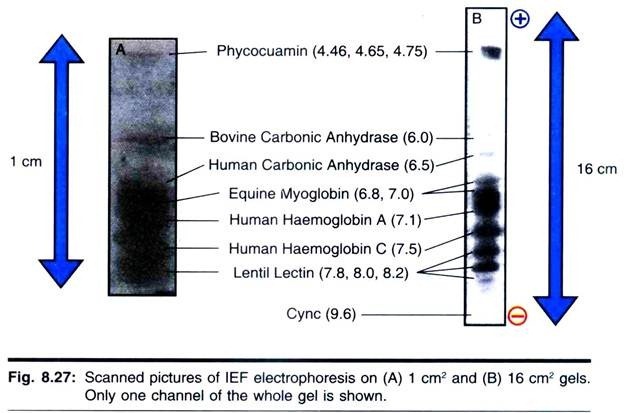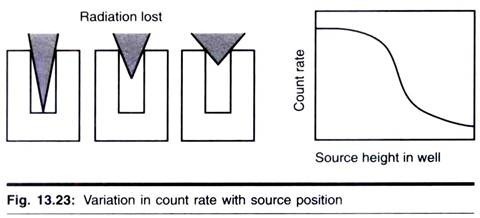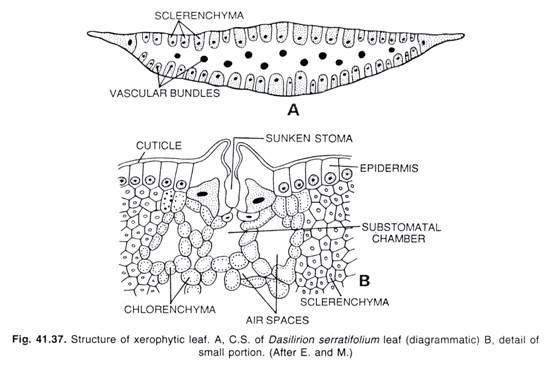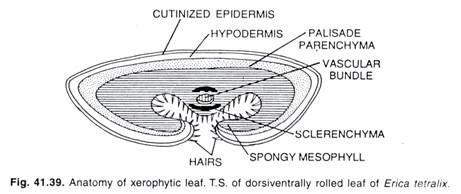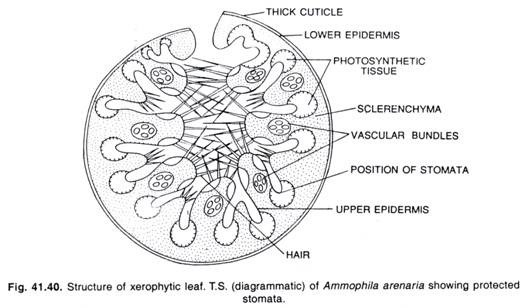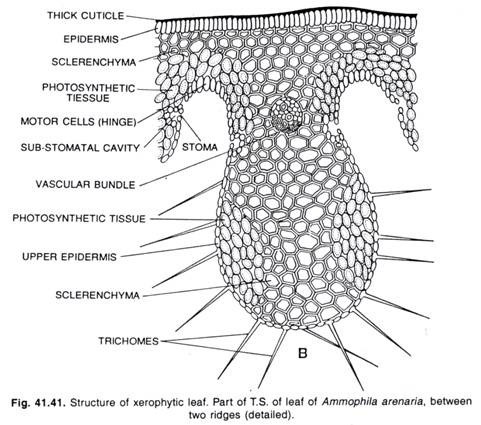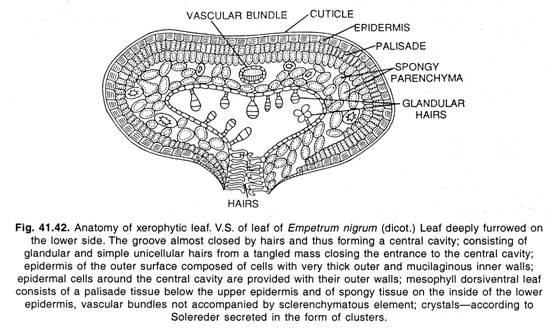ADVERTISEMENTS:
Let us learn about Ecological Anatomy. After reading this article you will learn about: 1. Adaptations to Water Stress –Ecological Anatomy 2. Anatomical Features of Ecological Group of Plants.
Adaptations to Water Stress –Ecological Anatomy:
The plants which characteristically grow in certain ecological niches often show a type of structure which is believed to be adapted to that particular environment. In the course of evolution, many species have become adapted in both structural and physiological features to habitats with an excessive water supply.
Plants that live wholly or partly submerged in water or in very wet places are known as hydrophytes (Gr. hudor, water; phyton, plant). The greatest numbers of plants grow under average conditions of moisture and temperature. Plants of habitats that usually show neither an excess nor a deficiency of water are known as mesophytes (Gr. mesos, middle; phyton, plant).
ADVERTISEMENTS:
Mesophytes are therefore, intermediate between hydrophytes and xerophytes. Plants that grow habitually where the evaporation stress is high and the water supply low show characteristic adaptations to a decrease in water content. They are known as xerophytes (Gr. Xeros, dry; phyton, plant).
The plants grow in desert or in very dry places; they can withstand a prolonged period or drought uninjured. They are really drought-resistant plants. Hydrophytes, xerophytes, and mesophytes are distinguishable as groups, since each has more or less definite habitat and characteristic appearance.
Between hydrophytes and mesophytes on the one hand, and extreme xerophytes and mesophytes on the other, they found all gradations of form and all degrees of structural adaptations due to intermediate habitats. Plants that grow upon other plants, but do not absorb food from them are known as epiphytes (Gr. epi, upon; phyton, plant), such as many orchids (e.g., Vanda).
Plants that grow in places rich in decaying organic substances, and derive their nutrition from them, are known as saprophytes (Gr. sapros, rotten; phyton, plant), (e.g., Montropa). Plants that grow upon other living plants and absorb their food material from them are known as parasites.
ADVERTISEMENTS:
For the purpose of the absorption of food the parasites develop haustoria, which penetrate into the tissue of the host plant, and absorb nutrition from it (e.g., Cuscuta).
Anatomical Features of Ecological Group of Plants:
Hydrophytes:
Plants grow in water or very wet places. They may be submerged or partly submerged, floating or amphibious. Their structural adaptations are mainly due to the high water content and the deficient supply of oxygen.
The various adaptations are as follows:
(i) The reduction of protective tissue (epidermis here is meant for absorption and not for protection).
(ii) The reduction of supporting or mechanical tissue (i.e., lack of sclerenchyma).
(iii) The reduction of conducting tissue (i.e., minimum development of vascular tissue).
(iv) The reduction of absorbing tissue (roots chiefly act as anchors, and root hairs are lacking).
(v) There is special development of air-chambers (aerenchyma) for aeration of internal tissues.
Epidermis:
ADVERTISEMENTS:
In aquatic plants, the epidermis is not protective but absorbs gases and nutrients directly from the water. The epidermis in the typical hydrophyte has an extremely thin cuticle, and the thin cellulose walls permit ready absorption from the surrounding water.
Commonly the chloroplasts are found in epidermal cells of leaves, especially when the leaves are very thin; these chloroplasts utilize the weak light under water for photosynthesis. In submerged plant, stomata are not present, and exchange of gases takes place directly through cell walls. The floating leaves of aquatic plants have abundant stomata on the upper surface.
Lack of sclerenchyma:
Submerged plants usually have few or no sclerenchymatous tissue and cells. The water itself gives support to the plant, and protects it to some extent from injury. The thick walls of tissues, their density and the presence of collenchyma in some plants give some rigidity.
ADVERTISEMENTS:
The strands of sclerenchyma occasionally occur, especially along the leaf margins, and increase tensile strength. A few star shaped idioblasts or sclereids are present, which give mechanical support to the body of aquatic plant (e.g., Limnanthemum, Nymphaea).
Minimum development of vascular tissue:
In the vascular tissues, the xylem shows the greatest reduction and in many aquatic plants consists of only a few elements, even in the stele and main vascular bundles (e.g., Elatine alsinastrum). In some aquatic plants (e.g., Potamogeton pectinatus, P. epihydrus), in the stele and large bundles, and frequently in the small bundles, xylem elements are lacking.
ADVERTISEMENTS:
In these plants there is well developed xylem lacuna in the position of xylem. These lacunae resemble typical air-chambers (air spaces). In many aquatic plants, the phloem is fairly well developed as compared with the xylem. The endodermis is usually present around the stele, but it is weakly developed.
Reduction of absorbing tissue:
ADVERTISEMENTS:
The root-system in hydrophytes is feebly developed and root hairs and root cap are absent. In some floating plants such as Utricularia, Ceratophyllum, etc., no roots are developed, and in submerged plants such as Vallisneria, Hydrilla, Naias, etc., water dissolved mineral salts and gases are absorbed by their whole surface.
In plants like Pistia, Eichhornia, Lemna, etc., no root cap develops, but root pocket is formed instead. An aquatic plant is, in reality, submerged in or floating upon a nutrient solution. In hydrophytes the root system is functioning chiefly as holdfasts or anchors, and a large part of the absorption takes place through the leaves and stems.
Development of air-chambers:
Chambers and passages filled with gases are commonly found in the leaves and stems of hydrophytes. The air chambers are large, usually regular, intercellular spaces extending through the leaf and often for long distances through the stem (e.g., Potamogeton, Pontederia).
ADVERTISEMENTS:
The spaces are usually separated by partitions of photosynthetic tissue only one or two cells thick. The chambers prepare an internal atmosphere for the plant. These air- chambers on the one hand give buoyancy to the plant for floating and on the other they serve to store up air (oxygen and carbon dioxide).
The carbon dioxide that is given off in respiration is stored in these cavities for photosynthesis, and again the oxygen that is given off in photosynthesis during the daytime is similarly stored in them for respiration. The cross partitions of air passages, known as diaphragms, prevent flooding.
The diaphragms are provided with minute perforations through which gases but not water may pass. Another specialized tissue frequently found in aquatic plants that gives buoyancy to the plant parts on which it occurs is aerenchyma. The presence of this type of aerenchyma is characteristic of species of Decodon and Lythrum.
Here, very thin partitions enclose air spaces and the whole structure consists of very feeble tissue. Aerenchyma is phellem formed by a typical phellogen of epidermal or cortical origin. At regular intervals individual cells of each layer of phellem elongate greatly in the radial direction while the other cells of this layer remain small.
However, the term aerenchyma is applied to any tissue with many large intercellular spaces, but such aerenchyma is quite distinct from the typical aeranchyma mentioned above (of Decodon) which is of secondary origin.
List of Common Aquatic Plants:
ADVERTISEMENTS:
Submerged— Vallisneria, Potamogeton, Hydrilla. Floating—Ceratophyllum, Pistia, Utricularia, Eichhornia, Trapa, Neptunia.
Plants with floating leave— Nymphaea, Nelumbium, Victoria regia, Euryale, Limanthemum.
Amphibious plants— Ranunculus aquatilis, Sagittaria, Limnophylla, Cardenthera, Typha, Alisma, Myriophyllum heterophyllum, etc.,
Mesophytes:
They grow in habitats that are neither extremely dry nor wet. These are plants that grow under average conditions of temperature and moisture. They are supposed to be intermediate between hydrophytes and xerophytes.
In mesophytes the root system is well developed with the tap-root and its branches in dicotyledons, and a cluster of fibrous roots in monocotyledons; root hairs are abundantly produced for the absorption of water from the soil.
The stem is solid, erect and normally branched. All the different kinds of tissues, particularly the mechanical and conducting tissues, have reached their full development in the mesophytes. The aerial parts of plants such as the leaves and the branches are provided with cuticle. In dorsiventral leaves the lower epidermis is provided with numerous stomata; there are few stomata or none at all on the upper surface.
In erect leaves, as in most monocotyledons, stomata are more or less equally distributed on both surfaces. The stomata are relatively uniform in structure and the guard cells show a maximum capacity for movement. The anatomy of mesophytic plants is quite normal and no special adaptations are found in them.
Xerophytes:
They grow in deserts or in very dry places; they can withstand a prolonged period of drought uninjured, for this purpose they have certain peculiar adaptations. The xerophytic plants have to guard against excessive evaporation of water; this they do by reducing evaporating surfaces.
Plants produce a long tap root which goes deep into the sub-soil in search of moisture. To retain the water absorbed by the roots, the leaves and stems of some plants become very thick and fleshy (e.g., Aloe, Agave). Water tissue develops in them for storing up water; this is further facilitated by the abundance of mucilage contained in them.
Multiple epidermis sometimes develops in the leaf (e.g., Nerium). Modification of the stem into phylloclade for storing water and food and at the same time performing functions of leaves is characteristic of many desert plants (e.g., Opuntia and other cacti).
In xerophytes certain structural features are also common. Leaves are thick and leathery, with a well developed cuticle and abundant hairs. Well differentiated mesophyll is also present, and there is often more than one layer of palisade tissue (e.g., Nerium, Hakea). The walls of epidermal and sub-epidermal cells are frequently lignified, and a distinct hypodermis, may be present.
They have a well developed vascular system and often an abundance of sclerenchyma, either in the form of sclereids or fibres (Hakea, Ammophila). The leaf is sometimes cylindrical or rolled. This organization is to protect the stomata, which may occur in furrows. Certain fleshy leaves (e.g., Sedum), contain abundant thin-walled cells, the water storage tissue.
The characteristic anatomical features of the xerophytes are as follows:
Epidermis and Thick Cuticle:
Heavy cuticularization and extreme cutinization of the epidermis and even of sub-epidermal cells are common in xerophytes. The thickness of the cuticle shows various gradations. In certain cases the thickness of cuticle is only slightly greater than normal, like that of plants of semi- xerophytic habitats.
In extreme xerophytes the cuticle may be as thick as, or thicker than the diameter of the epidermal cells. In addition to the presence of thick cuticle, the walls of epidermal cells become cutinized, and sometimes also those of underlying cells. Along with well-developed cutinized layers the epidermal and sub-epidermal cells also become lignified.
For example, in the leaflets of Cycas, the lignification may extend even to the palisade parenchyma cells. In certain cases the covering of wax is formed on the epidermis (e.g., Calotropis). The epidermal cells are usually radially elongated. In the leaves of Nerium and Ficus, the epidermis becomes multi-layered.
In many xerophytes, in addition to a cutinized epidermis, single to multi-layered hypodermis is also present. In most plants, the hypodermis of leaves is morphologically mesophyll and may be in the form of sheet of fibrous tissue or a layer of sclereids.
The hypodermis of the stems seems to be a part of the cortex. The hypodermis of stem and leaves may be cutinized to lignified. In many plants, the mucilage, gums and tannins are commonly found in the hypodermis.
Hairs:
In many xerophytic plants, especially those of alpine regions exposed to strong winds, a covering of matted epidermal hairs on the underside of the leaves prevents water loss. Hairs may also be abundant over the entire aerial part of the plant.
The thick matting of hairs also prevents rapid evaporation through stomata. The xerophytes that possess abundant hairs, on their leaves and stems, are commonly called trichophyllous.
Structure of Stomata:
The stomata are very minute openings formed in the epidermal layer in green aerial parts of the plants.
The stomata are essential for intake of carbon dioxide and oxygen and for the passage inward and outward of other gases. The evaporation of the surplus water takes place through the stomata. When the stomata are open, water escapes even when water loss is harmful to the plant.
This way, the reduction of transpiration is of great importance in xerophytes. The xerophytes may possess less stomata, either by reduction of leaf surface or of stomatal number per unit area. To reduce excessive transpiration, usually the stomata that remain sunken in pits are formed.
Such stomata are commonly known as sunken stomata (e.g., Pinus, Hakea, Agave, etc.). In certain cases the stomata are found in groups and they remain confined to depressions found on leaf surface (e.g., Nerium, Banksia, etc.). Usually the depressions contain hairs in them which protect the stomata from direct attack of wind gusts.
Sclerenchyma:
The xerophytes commonly have a larger proportion of sclerenchyma in their leaf structure than is found normally in mesophytes. The sclerenchyma is either found in groups or in continuous sheets. For example, in Banksia, there is a continuous thin sheet of sclerenchyma between the hypodermis and the mesophyll.
In Dasylirion, there is well-developed sclerenchyma below the epidermis. The sheets of sclerenchyma check excessive transpiration to some extent and also give mechanical support to the plant body. The xerophytes that possess heavy sclerification of the leaves are known as sclerophyllous.
Rolling of leaves:
The leaves of many xerophytic grasses roll tightly under dry conditions. In these grasses, the stomata are confined to the ventral surface of the leaf, so that when the leaf edges roll inward, the stomata are effectively shut away from the outside air.
As the stomata are located on the inner surface of the leaf, the air enclosed by the rolled leaf soon becomes saturated with water under the outward water diffusion stops.
In Ammophila arenaria, there is tight upward folding of the leaf and also the sheltered location of the stomata in furrows, greatly reduce air movement over stomatal areas. Special motor cells (hinge) on the upper surface of the leaf are responsible for the inward rolling of leaves. In the xerophytic grasses, the motor cells are well developed.
Reduced leaf surface:
In many xerophytes, the reduction of the leaf surface partly prevents water loss because the total exposed surface of the plant body is relatively small as compared with that of normal mesophytes (e.g., Equisetum, Pinus, Casuarina, Asparagus, etc.). In such xerophytes the leaves are either scale-like or very small in size. Usually they are not found in the mature plant, or they persist as small scales or bracts.
In some plants (e.g., Equisetum, Polygonella, etc.) the photosynthesis takes place in the stem where assimilatory tissues are well developed. The reduction of leaf surface is usually accompanied by well-developed sclerenchyma water storage tissue and sunken stomata. Xerophytes, with reduced leaves, are known as microphyllous.
Needle leaves of gymnosperms:
The needle leaves of gymnosperms are of microphyllous type. In the leaves of many conifers, in addition to reduced leaf surface there are heavy cutinization and sunken stomata. A characteristic illustration of this type is the needle of Pinus.
The outer walls of the epidermal cells are cutinized. The wall is so much thickened that the lumen of the cells is nearly obliterated. The stomata are sunken and arranged in definite longitudinal rows. Beneath the epidermis there is well developed hypodermis, consisting of elongate sclerenchyma cells.
Water storage tissue:
Many fleshy xerophytes possess water storage tissue and mucilaginous substance in them. In leaves such tissues are located beneath the upper or the lower epidermis, or upon both sides of the leaf and sometimes in the centre too. The storage cells are usually large and often thin-walled, as in Begonia.
The storage tissue may actually serve as a source or reserve water during drought. The xerophytes that possess fleshy leaves or stems are known as malacophyllous.
Abundant palisade parenchyma:
In the stems of many xerophytes, the palisade tissue is present (e.g., Capparis decidua). In the xerophytic leaves the palisade is abundant and compactly arranged.
Latex tubes:
In many xerophytic stems and leaves the laticiferous canals are present (e.g., Calotropis, Euphorbia, Asclepias, etc.). Due to viscosity of latex the transpiration is reduced to some extent.
List of Common Xerophytic Plants:
Several species of Euphorbia (e.g., Euphorbia tirucalli, E. royleana, E. neriifolia, etc.); many cacti (e.g., Opuntia, Cereus, Pereskia, etc.); Agave, Aloe; Capparis decidua; Calotropis procera; Carthamus; Portulaca; Argemone mexicana; Salsola; Alhagi, Ammophila arenaria; Dasylirion serratifolium; Nerium; Banksia; Hakea; Casuarina; Erica; Empetruni and several others.



